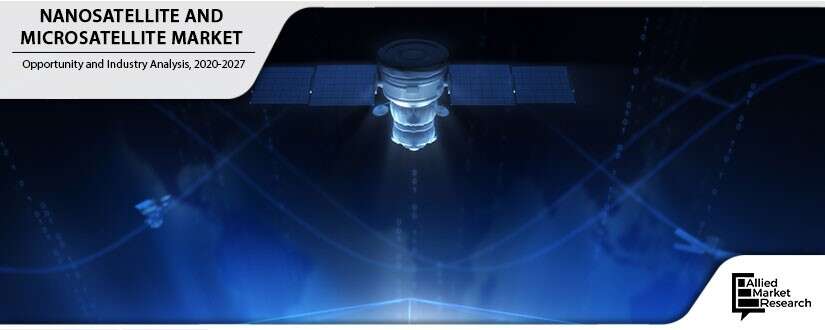Microsatellites and nanosatellites are miniaturized man-made satellites that are used for collecting information about the earth and space, among other uses. According to NASA, these satellites are classified on the basis of their overall mass. Microsatellites are artificial satellites, with a mass of 11–100 kg (including fuel mass) while nanosatellites are artificial satellites weighing between 1 and 10 kg, and measuring around 30 cm × 10 cm × 10 cm. Nanosatellites with standard dimensions (“U” or Units) of 10 × 10 × 11 are known as CubeSats. These satellites can be 1U, 2U, 3U, or 6U in size, and typically weigh less than 1.33 kg (3 lbs) per U.
Microsatellites and nanosatellites are more cost-effective than traditional satellites and usually developed for communication, commercial, and space research purposes. The demand for these satellites has increased significantly over the last few years, owing to their lightweight attribute, shorter development cycle, high capability of performing complex computational tasks, and lower cost for development and launch. Major and upcoming companies, such as Planet Labs, GomSpace, Sierra Nevada Corporation, among others, are launching constellations of micro and nanosatellites to offer near real-time remote sensing data.
Microsatellite and Nanosatellite Industry Dynamics
The demand for microsatellites and nanosatellites is increasing significantly in the recent years. According to nanosats.eu, as of January 2021, more than 2,900 nanosatellites were launched in the earth’s orbit. Companies across the globe are launching constellations of nanosatellites or microsatellites in the earth’s orbit for earth observation and telecommunication applications such as high-speed space-based internet services. For instance, in January 2020, Sateliot, a Spain-based nanosatellite and telecommunications operator, signed a Memorandum of Understanding (MoU) with the European Space Agency (ESA) to analyze, develop, and implement innovative technologies, products, and services with space capability using 5G. The company is planning to invest around 100 million Euros to launch constellation of 20 nanosatellites for hybrid terrestrial space networks, 5G network architecture, spectrum management, and spectrum exchange.
 Moreover, microsatellites and nanosatellites can provide high-resolution imagery for monitoring and verifying applications in various sectors, including civil engineering & construction, defense & intelligence, agriculture & forestry, transportation, real estate, government, and others. Satellite imaging is applicable in topographic mapping, understanding land applications such as infrastructure planning & construction, exploitation of new energy sources, mitigating the impact of disasters, and monitoring drilling projects of the oil & gas industry. Moreover, high-resolution satellite imagery assists in monitoring vegetation, green mapping, vegetation damage due to leaching, traffic management, tracking of fleet, and others. In the coming years, satellite imaging is expected to be significantly used in the real estate industry for enhanced view of buildings and properties, and in the insurance sector for accessing environmental risk through accurate and updated geographical data. Many countries across the globe are collaborating with the microsatellites and nanosatellite manufacturers for satellite imaging. For instance, in 2020, Space-SI, the Slovenian Centre of Excellence for Space Sciences and Technologies, launched a microsatellite collaborated with Space Flight Laboratory and launched the county’s first microsatellite NEMO-HD carrying a multispectral high-definition Earth observation instrument. This instrument collects high-definition video at 25 frames per second. The video data and imagery acquired by this satellite will be used to monitor forestry, agriculture, urban development, and marine transport.
Moreover, microsatellites and nanosatellites can provide high-resolution imagery for monitoring and verifying applications in various sectors, including civil engineering & construction, defense & intelligence, agriculture & forestry, transportation, real estate, government, and others. Satellite imaging is applicable in topographic mapping, understanding land applications such as infrastructure planning & construction, exploitation of new energy sources, mitigating the impact of disasters, and monitoring drilling projects of the oil & gas industry. Moreover, high-resolution satellite imagery assists in monitoring vegetation, green mapping, vegetation damage due to leaching, traffic management, tracking of fleet, and others. In the coming years, satellite imaging is expected to be significantly used in the real estate industry for enhanced view of buildings and properties, and in the insurance sector for accessing environmental risk through accurate and updated geographical data. Many countries across the globe are collaborating with the microsatellites and nanosatellite manufacturers for satellite imaging. For instance, in 2020, Space-SI, the Slovenian Centre of Excellence for Space Sciences and Technologies, launched a microsatellite collaborated with Space Flight Laboratory and launched the county’s first microsatellite NEMO-HD carrying a multispectral high-definition Earth observation instrument. This instrument collects high-definition video at 25 frames per second. The video data and imagery acquired by this satellite will be used to monitor forestry, agriculture, urban development, and marine transport.
The growing focus on reducing the cost of miniature satellites propels the growth of the market. Miniature satellites can be manufactured using low-cost and reusable hardware components & equipment. The use of miniature satellites can reduce the launch expenses by up to 40% as these satellites are small, lightweight, and do not need a dedicated launch vehicle as traditional satellites. Technological advancements, in terms of miniaturization of components and associated software, have encouraged established organizations and SMEs to invest in small satellites. Advancements in microelectronics, such as lightweight apertures, antennas, panels, trans-receivers, control sensors & actuators, and multispectral imagers, are expected to increase the efficiency and processing power of small satellites, reducing the complexities associated with traditional satellites, thereby making them easy to assemble and test. The introduction of reusable space launch vehicles, which could be used for multiple missions, is expected to reduce the costs associated with small satellites. This is expected to result in increase in adoption of microsatellites and nanosatellites.
However, microsatellites and nanosatellites have typically smaller budgets and development time-scales. Moreover, the process of procuring the launch is complex for small satellite operators. Therefore, the absence of dedicated launch vehicles for the delivery of small satellites to orbit presents a significant barrier for the microsatellite and nanosatellite market. Moreover, rise in concern for space debris due to increasing launch of microsatellites and nanosatellites restrains the market growth. Contrarily, increasing participation from private players and research & academic institutes; increasing demand for low earth observation (LEO) based services; and growing new space movement present new pathways in the industry to provide lucrative opportunities for the growth of the market.
Trends
Technological advancement and path-breaking innovation have created in a new era of earth observation, making satellites more relevant across businesses. Currently, small satellites, such as nanosats and microsats, are capable of sending terabytes of data and images of an earth on daily basis, enabling varieties of AI driven applications that provide previously inaccessible insights on a global scale in social and industrial processes. AI is disrupting every field, and the earth and space observation sector is no exception. The earth observation industry is reimagining itself and witnessing an increasing use of specified algorithms when cloud and Big Data have become ubiquitous. With the advent of AI, data from space is becoming more accessible and available faster for businesses and governments. Machine learning algorithm has become a powerful tool for analyzing satellite imagery of any resolution and providing better insight. Moreover, these satellites are using Ultra High Frequency (UHF) and Very High Frequency (VHF) bands to increase signal frequency. This increases the speed and reliability of data transfer.
The nanotechnology industry is disrupting the satellite and space industry by offering cheaper and versatile solutions. Affordable satellite connectivity enabled by nanosatellite technology can increase the adoption rate of Internet of Things (IoT) in developing markets and unlock IoT services across remote locations where communication infrastructure is absent.
COVID-19 Impact
The outbreak of COVID-19 has forced the World Health Organization to declare a pandemic status. The COVID-19 pandemic has swept the world, with many industries are trying to stay afloat. The government and business involved with space are reacting differently to the new situation. During the COVID-19 crisis, many large satellite launches were canceled or postponed. The launches of majority of microsatellite and nanosatellite are dependent on large satellites as microsatellite and nanosatellite are dependent on launch vehicles of large satellites for the delivery of small satellites to orbit. This has drastically impacted the market for microsatellite and nanosatellite.
Furthermore, due to the COVID-19 pandemic, small and medium-sized companies in the satellite industry may face liquidity challenges in the short term and may struggle to survive without support from their investors. According to a survey of Korea Association for Space Technology Promotion, 66% of space companies surveyed in March 2020 are anticipated to have negative impacts throughout 2020. Moreover, 42% of companies are expecting to recover business in the first half of 2021. According to the United State Department of Commerce’s study on the space industrial base, in the U.S., around 90% of space firms with Research and Development (R&D) as a primary business line were small businesses. These SMEs are mostly the only source providers of critical equipment, parts, and services. The negative impact of the pandemic on the business of these SMEs is anticipated to create major challenges in the near future. Moreover, as governments across the globe are focusing on healthcare due to the pandemic, the space budget of many countries has reduced, which is directly affecting the market growth.
However, the COVID-19 pandemic also created an opportunity for existing satellite operators. The demand for earth observation and satellite communication has increased significantly during the pandemic. The operators are using the data gathered from their satellites to study the impact of COVID-19 on the earth’s environment. For instance, NASA, Japan Aerospace Exploration Agency (JAXA), and the European Space Agency (ESA) are keeping track of how COVID-19 has changed the global economy and environment. Moreover, the images collected from satellites are used for tracking the coronavirus spread and to control the pandemic. Therefore, attributed to these factors, the demand for satellite data is expected to propel significantly during the pandemic.
According to a recent report published by Allied Market Research, titled, Microsatellite and Nanosatellite Market gives detailed analysis of the pandemic on the market. This includes the current impact on the revenue, sales, and new measures taken by players, among others. For more information go to: https://www.alliedmarketresearch.com/request-sample/7856
----------------------------------------
 Mayank Halmare is a seasoned market research and consulting professional. He has experience of working on various successful consultation projects with well-known brands in Aerospace and Defense industry such as Sierra Nevada Corporation, Airbus, Planet Labs Inc., and others. His expertise has helped clients across the globe to formulate successful business strategies which contributes significantly in growth of the company. He holds a bachelor’s degree in Mechanical engineering and Master’s degree in MBA from one of the topmost educational institute. He can be reached at: mayank.halmare@alliedanalytics.com
Mayank Halmare is a seasoned market research and consulting professional. He has experience of working on various successful consultation projects with well-known brands in Aerospace and Defense industry such as Sierra Nevada Corporation, Airbus, Planet Labs Inc., and others. His expertise has helped clients across the globe to formulate successful business strategies which contributes significantly in growth of the company. He holds a bachelor’s degree in Mechanical engineering and Master’s degree in MBA from one of the topmost educational institute. He can be reached at: mayank.halmare@alliedanalytics.com





